1900s
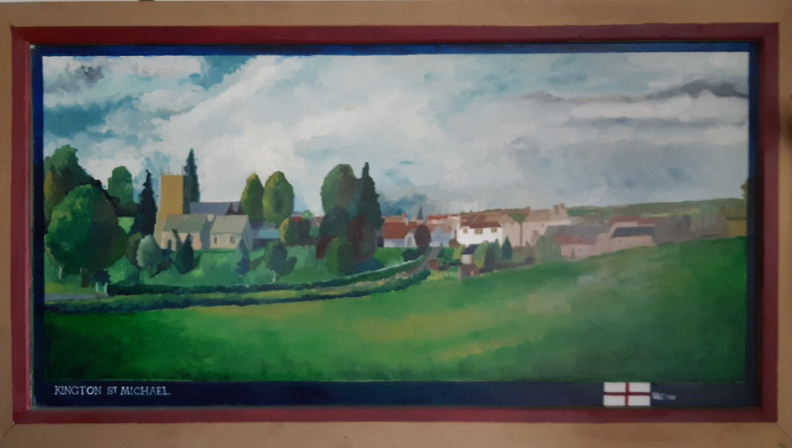
Painting of Kington St Michael by villager John Hall (1943 - 2025)
1991
Kington St Michael "At Home" Day
Back in September 1991 the village held an "At Home" day to raise money for village organisations. Please click here to view a copy of the programme.
The photo below is of some representatives of St Nicholas Playgroup (now Acorns Pre-School).
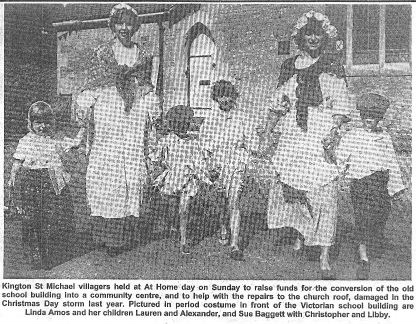
(Left to right: Libby Baggett, Linda Amos (now Durno), Alexander Amos,
Lauren Amos, Sue Baggett & Christopher Baggett)
Changing telephone numbers
In 1991 villagers were notified that their telephone numbers would be changing - click here to read the letter from BT.
1989
Here's an aerial view of the south end of Kington St Michael, taken in 1989. Note that Rose Cottages and Paddock End had not yet been built, and neither had Manor Close (where the PM Mendes warehouses are).
1985
Moorshall Cottages
Back in the summer of 1979 Moorshall Cottages, on the road out towards Grittleton, lay derelict but by 1985 had been bought and renevated.
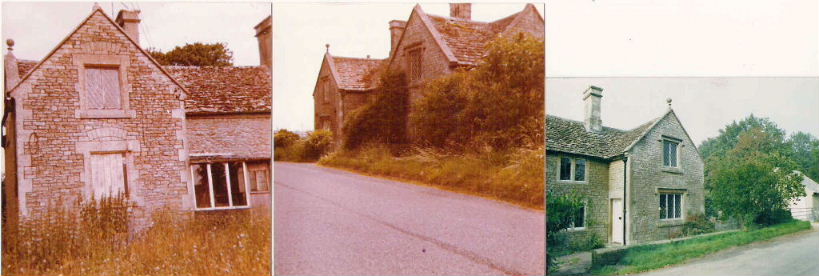
Moorshall Cottages, derelict in the summer of 1979 (x 2 LH photos)
and renevated by 1985 (Photos courtesy of Linda Durno)
Journalist's visit
In 1985 the late journalist, Miles Kington, visited the village and in particular the church. Click here to read his ponderings, published in The Times on 17th January 1985.
1977 Queen Elizabeth II's Silver Jubilee
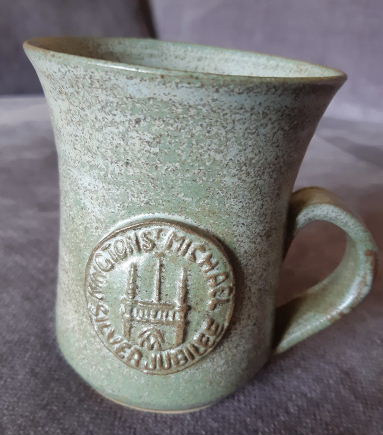
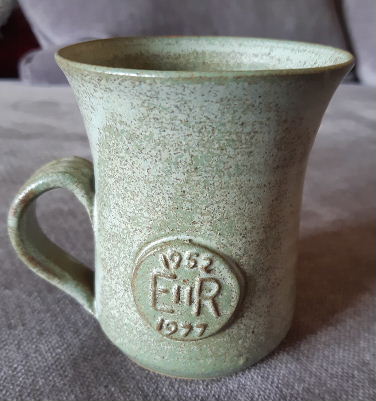
This mug was produced for Kington St Michael’s
celebrations of Queen Elizabeth II’s Silver Jubilee in 1977, and one was given
to every child in the village. The mugs
were made by Maureen Hall (1943 – 2017), a potter from the village, who was
very much involved with many aspects of village life, from the Parish Council,
to the social club, the village hall, the community shop, the Alms Houses, and more.
1940s Evacuees
During WWII, Miss Bessie Pearce of Grove Cottage, Grove Lane* took in many evacuees, along with Miss Hilda Birchall (believed to be an evacuee herself). Some stayed for a short time, while others were in the village for longer. One such evacuee, Arthur Novis, moved on to Australia in 1948, together with his sister Maureen, with fond memories of his time in the village and of "Auntie Bessie".
Arthur also recalled hearing the pastor of the Bethesda Chapel (possibly a Mr Taylor) ride up along Grove Lane in the early morning. Village family names he recalled are Curtis, Duckett, Farr and Henley.
(* now Grove Cottage, 44 Kington St Michael)
1924
Excerpt from a group villages' gazette of August 1924, with many thanks to Nigel Farr. The Farrs mentioned were his Great Grandfather and his late first wife.
1923Kington St Michael Club's History
The club
was opened in 1923, extended and improved in the late 1980s
and underwent renovation in 2003.
It was affiliated to the 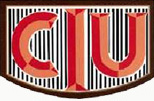 Working Men's Club & Institute Union Ltd - website.
Working Men's Club & Institute Union Ltd - website.
Here's a photo of the club taken on 9th February 2003, before the renovations, and mid-renovation later that year:
The Club in 2003
1914Kington St Michael World War I Records of the Fallen
Please click here to view the records of war graves of those from Kington St Michael who lost their lives in World War I.
1914 Directory of Wiltshire Entry
Thank you to Elaine Arthurs for providing these photos of an entry in a 1914 directory of Wiltshire. The Epileptic Home referred to was in what is now known as Hazeland House.
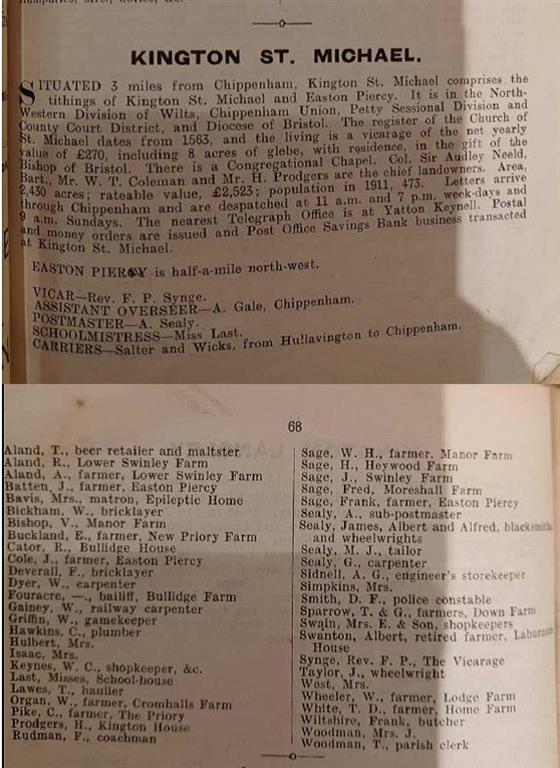 ~*~*~*~
~*~*~*~
1913
Many thanks to Tim Sage for sharing these photographs of the baptism and confirmation certificates of his ancester, Maurice Arthur Sage. The baptism took place in St Michael & All Angels Church in 1913 and the confirmation at St John the Baptist Church in Charlton near Malmesbury, in 1931.
1901
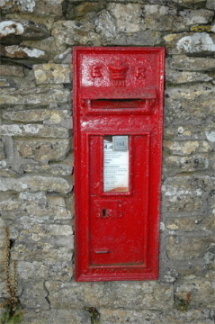
(Photo courtesy of Niki Willows)The post box down by Stanton Lane is an Edward VII one. To find out more visit the Letter Box Study Group.
Memories of Kington St Michael
Memories from KSM WI Members
Coal was delivered once a week. Apparently someone was having some of their coal stolen, so they made a hole in a piece of coal and put some explosive in it. The culprit was soon exposed by the bang when he put it on his fire!
The owner of Kington Manor used to arrange an annual outing for the children of the village and as a treat they were each given an orange to eat.
Wartime (WWII)
Some bombs meant for Hullavington were dropped behind Priory Cottage and people from all around came to see the craters “big enough to put a house in”. Barbara Tinson recalled coming out of school at midday and a German bomber flying low overhead machine-gunning, so she quickly hit the floor. Many unexploded incendiaries were collected up and kept on Mr Lee the shopkeeper’s lawn, which was behind the club! Italian prisoners of war were held in Chippenham and used to come to the village to join the local men doing vital agricultural work.The village also housed evacuees during the war.
Winter Memories
1963 was probably one of the most sever winters in recent memory and there was deep snow through the village. Some children walked through snow drifts from behind The Plough to school, only to be told that the toilets were frozen so they must return home! Later when the snow melted, they realized they’d walked on top of the hedges.
A Bride's Tale from the 1960s
Sylvia Hyland (who now lives in Whitley Bay) has very kindly sent in her memories of her time in Kington St Michael in the 1960s, when she lived at Kington Manor and then at Tor Hill. At that time her husband worked for the Heidelberg Printing Company, which owned the Manor and its grounds. Please click here to read Sylvia's story.
Memories of Kington St Michael by Charlene Ellis (née Morse)
Many thanks to Charlene Ellis who has sent in her childhood memories of Kington St Michael and a history of her family's connection with the village. Please click here to read her story.
Nostalgia from the Files of the Gazette Newspaper
August 1990: "An ancient well has been discovered which may have been the village water supply in mediaeval times. A resident was clearing ground at the back of his house to make way for an extension when he stumbled across the rare find. A casual swipe on a hefty-looking paving slab revealed a bottle-shaped cavern beneath. Thamesdown Archaeological Unit's director said the house may be the oldest in the village, possibly dating from as far back as the Middle Ages."
August 1985: "Lead levels on the playground equipment are 12 times the acceptable limit, the parish council has told the company which supplied the equipment six years ago. In reply, the Kettering-based firm which supplied the slide, swings, climbing frame and rocking horse said there was no legal obligation to reduce lead levels in paint. The parish council decided to get the equipment stripped and repainted. It is now obtaining quotes for the work, which is expected to cost nearly £1,000."
September 1915: “It is quite a common occurrence to see aeroplanes passing overhead, but Tuesday afternoon was the first time that one has actually descended in the village. About 3.30pm a bi-plane was noticed coming from Salisbury Plain, and it was soon evident that the aviator meant to descend. Coming from the direction of Tor Hill he began to circle round getting gradually lower, until he was just skimming over the trees in the churchyard; then with a beautiful glide he brought his machine down in the large field adjoining the squire’s drive. The pilot proved to be the Master of Sempill, and whilst he and a fellow officer who accompanied him went up to Kington House [now Kington Manor], a large crown assembled and examined the aeroplane with great interest. About 5pm the aviators started on their return journey amid the cheers of hundreds of spectators.”
N.B. Kington Manor was the home of his maternal grandfather, Herbert Prodgers, his mother being Lady Gwendolen Emily Mary Forbes-Sempill (née Prodgers), wife of 18th Baron Sempill.
May 1911: "At the Chippenham Rural District Council on Monday, Dr Briscoe reported a serious outbreak of diptheria at Kington St Michael. There were eight cases and one death. As far as he was able to make out, a child attended school for four days whilst suffering from the disease and infected the other children. Accompanied by the surveyor, Dr Briscoe found at the back of the school [now the village hall] was an open drain and two heaps of stable manure. The drain ought to be connected with the sewer and the owner was willing to do that."
December 1907: "A most excellent entertainment was given by the school children on Tuesday. Although the programme was long and varied, everything went without a hitch, the energy of the children and promoters carrying all before it. There were some first-rate recitations and dialogues by boys and girls of all ages, including a little girl of three, whose reciting powers were simply extraordinary."
October 1901: "Owing to there being no means of flushing, the village sewer is said to be an elongated cesspool and at every corner of the street there is a horrible smell. There is no means of flushing in the school lavatories and it is feared the school will have to be closed owing to the want of sanitary arrangements. The water in the wells is also said to be impure."
Thank goodness times have changed!